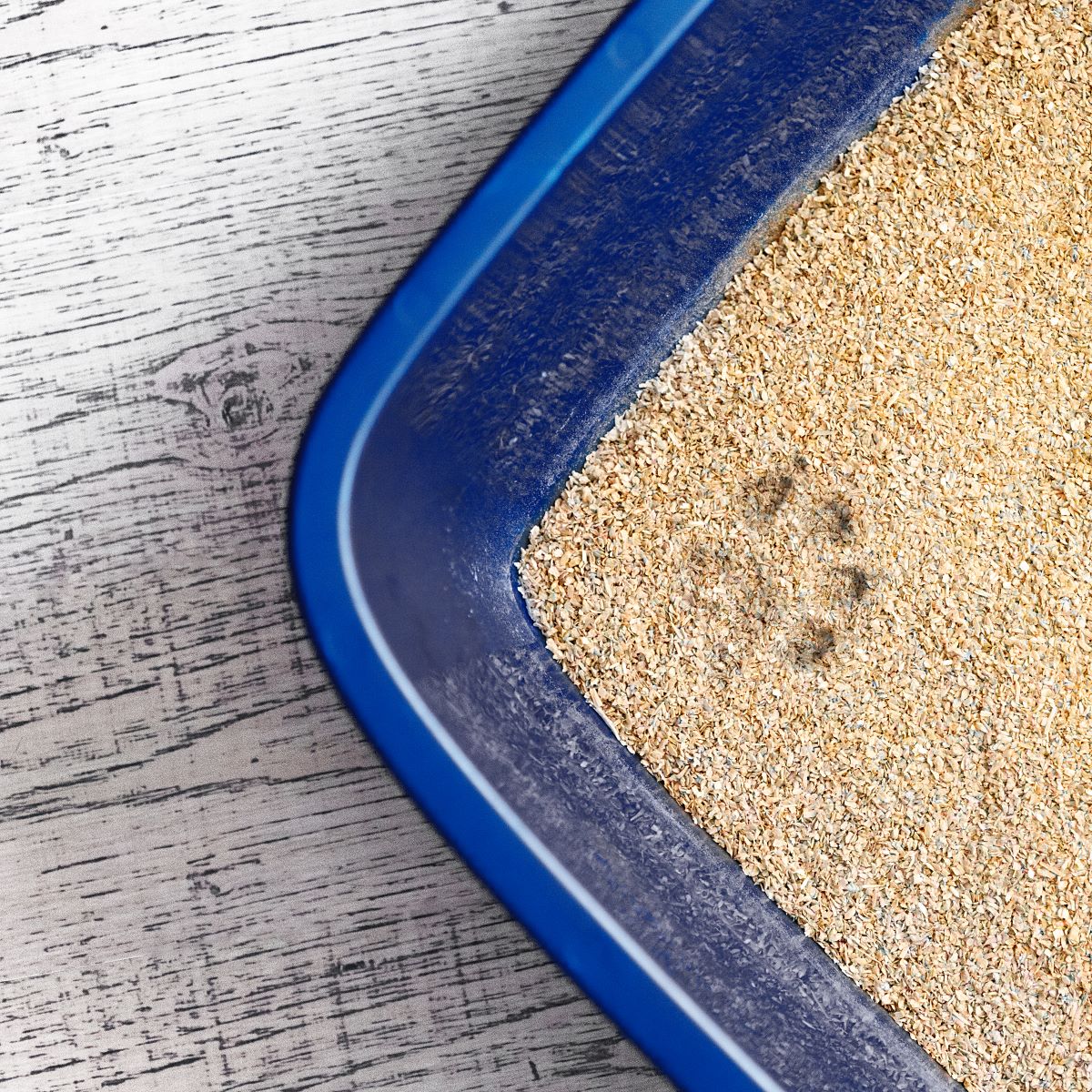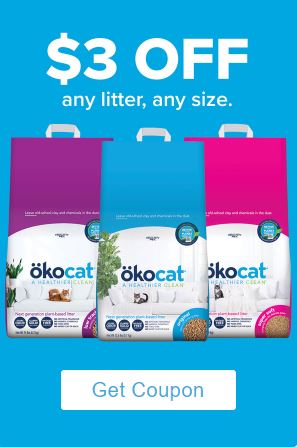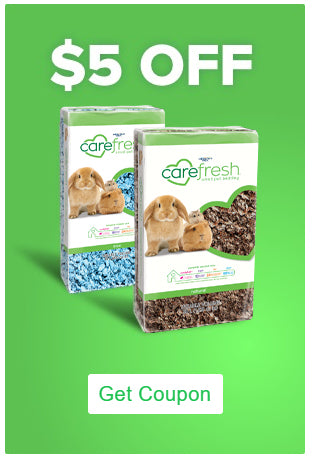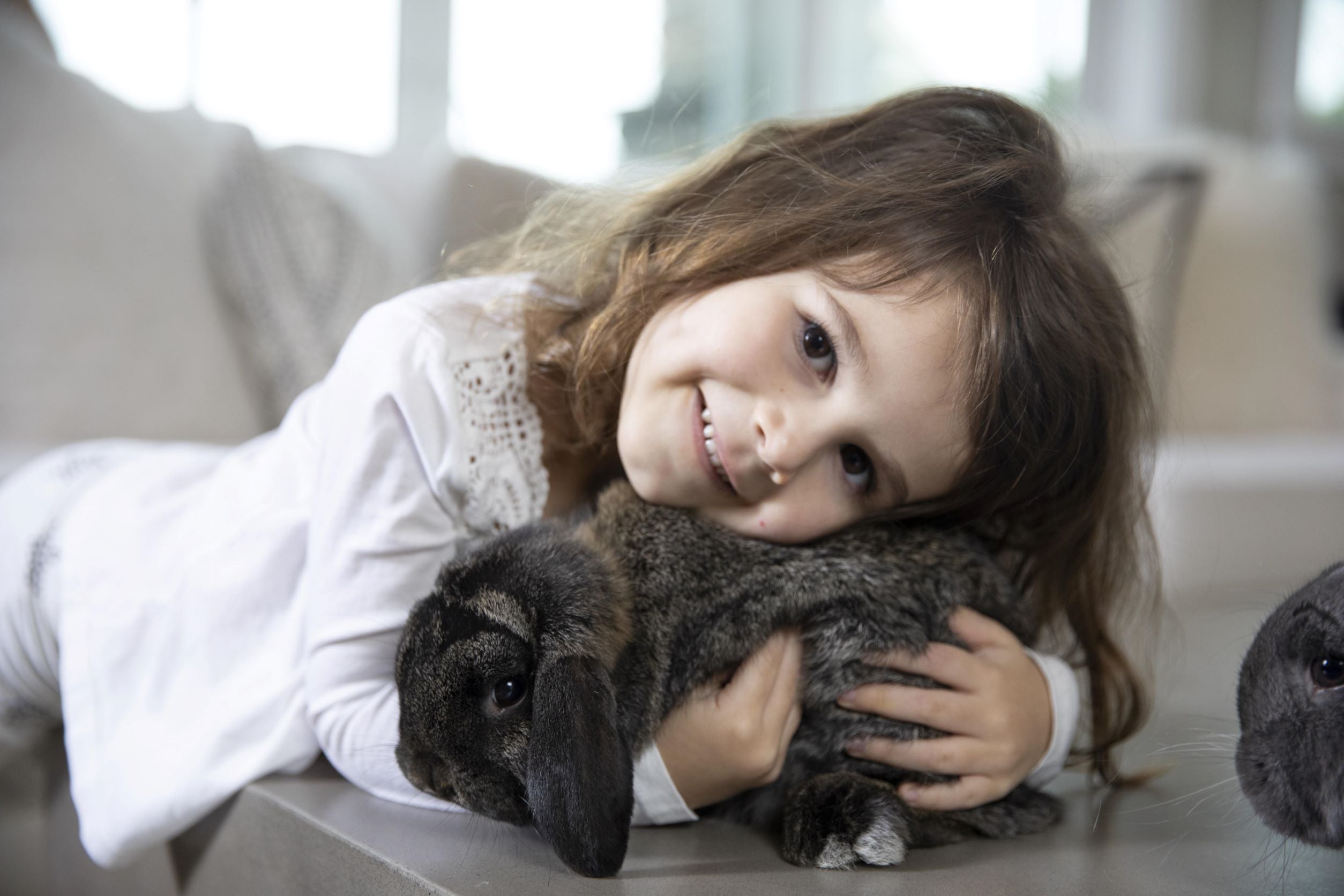Back to Basics: How to Set Up the Purr-fect Litter Box with ökocat® Natural Cat Litter
Let’s be real: nobody adopts a cat because they love scooping litter boxes. But the truth is, when you nail the basics, the litter box doesn’t have to be a daily battle. In fact, it can be… dare we say… easy. Your cat gets a clean, cozy bathroom, and you get a fresher home (and way fewer side-eye glares from your feline roommate).
So, let’s go back to basics—because the secret to a happy cat household might just start with the litter box.
Step 1: Pick the Right Box (Yes, It Matters)
Your cat may not be picky about sleeping on your laptop keyboard, but when it comes to their bathroom, they definitely have opinions.
Bigger is better: Think of it like this—would you rather use a cramped porta-potty or a roomy spa bathroom? Same goes for your cat.
Covered or uncovered? Some cats want privacy. Others? Exhibitionists. Let them decide.
One per cat, plus one extra: It’s the golden rule. Sharing is not caring when it comes to litter boxes.
Step 2: Ditch the Clay, Go Natural
Here’s where ökocat® natural litter shines (literally—it’s wood-based and kind of beautiful). Unlike dusty, perfume-heavy clay litters, ökocat:
Locks in odors naturally (so your cat’s bathroom doesn’t become your home’s signature scent).
Is 99% dust-free (breathe easy, whiskers included).
Eco-friendly (good for your cat, your home, and the planet).
Gentle on paws (imagine a soft forest floor instead of gravel—much nicer).
Step 3: Layer It Just Right
Cats love to dig and cover. The sweet spot? About 2–3 inches of ökocat. Too shallow and they can’t cover. Too deep and you’ve basically created a wood-chip beach.
Step 4: Location, Location, Location
Think about where you would want a bathroom. Not in the middle of the kitchen, right? Same goes for your cat.
Quiet, low-traffic areas work best.
Away from food and water (cats are clean freaks).
Skip the scary laundry room with the noisy spin cycle—no one wants that bathroom anxiety.
Step 5: Keep It Fresh (Without Losing Your Mind)
Here’s the routine:
Scoop daily (your cat will thank you with fewer “accidents”).
Top it off weekly with fresh ökocat.
Swap completely every 4–6 weeks. Bonus: ökocat’s natural odor control means you’ll do full cleanouts less often than with clay.
Back to Basics = Back to Happy Cats
At the end of the day, your cat doesn’t ask for much: a comfy nap spot, food on time, and a litter box that doesn’t make them cringe. Set it up right with ökocat natural litter, and you’ll both breathe easier (literally). Because a happy litter box = a happy cat = a happier you.
Read MoreCreating a Stylish, Pet-Friendly Home Without Sacrificing Your Sofa and Your Sanity
If you share your home with a wagging tail or a pair of muddy paws, you already know the struggle — your living room can go from Pinterest-worthy to chaos in seconds. And if you also have little kids, your couch might be holding on for dear life.
But the good news? You don’t have to choose between a stylish home and a functional one. Small changes can make a big impact, especially when they combine smart protection and easy care.
Mamma Mia Covers is a brand many pet parents are turning to. Designed with high-stretch, breathable fabrics and Italian-inspired patterns, these slipcovers are more than just practical — they’re actually pretty. Instead of scrubbing daily or tossing a blanket over the couch, just pop the cover into the wash and enjoy a fresh space every time.
The Reality of Living with Pets and Kids and Tips to Handle This
Dogs don’t wipe their paws, and kids never stop snacking on the sofa. Leather gets scratched, upholstery absorbs every scent, and fur finds its way into the seams. Trying to keep everything clean can feel like a full-time job. That’s why building a pet- and kid-friendly home is about prevention — not just cleanup.
Here are some low-effort, high-reward ways to keep your home looking polished while still being livable.
1. Swap the Cover, Not the Sofa
Your couch takes the most abuse. Instead of replacing it, cover it. Quality slipcovers from Mamma Mia Covers fit snugly thanks to the patented WavyProof™ and WavyTech™ technologies, so they don’t look like an afterthought. They stretch to fit various sofa sizes, and the anti-slip inserts keep them in place, even with dogs jumping on and off.
They’re made with OEKO-TEX® certified fabric, which means no harmful substances — safe enough for newborns, and tough enough for a Labrador. Machine washable and built to handle 200+ washes, they’re ideal for families who want low-maintenance solutions without sacrificing style.
2. Rethink Rugs and Floor Choices
While hardwood floors are beautiful, they’re slippery for older dogs and prone to scratches. Soft, low-pile rugs or indoor-outdoor styles can warm up the room while giving pets a place to relax. Look for stain-resistant options with non-slip backings to avoid accidents — literal and figurative.
Layering machine-washable rugs under the main furniture areas has made a big difference. It's a simple way to stay calm when muddy paws come charging in.
3. Keep Decor Functional
Forget fragile coffee table styling. When you live with pets or kids, décor needs to multitask. Storage ottomans hide toys and leashes, baskets keep throw blankets off the floor, and wall-mounted shelves save your favorite candles from curious noses and toddler hands.
Try switching to washable throw pillow covers and durable accent pieces that don’t mind a bit of rough handling. Cotton, microfiber, polyester, or performance fabrics will hold up better than silk, especially in rooms where your pets like to lounge.
4. Add Protection Where It Counts
Beyond the couch, think about areas that get frequent wear: armchairs, dining chairs, mattresses, and play areas. Reusable, waterproof covers or blankets can add a layer of protection while blending in with your decor.
Some families keep a soft, waterproof dog blanket on the bed or backseat, just in case. Such accessories help to protect your dog's favorite nap spot, and blend easily with your home décor. But more importantly, they save the upholstery and peace of mind, after every muddy walk.
5. Think Ahead with Easy-Care Materials
Fabrics matter. Linen looks great but snags and stains easily. Velvet adds a luxe vibe but may trap fur. When choosing textiles, aim for tightly woven, breathable materials that are durable and low-maintenance. Microfibers, cotton blends, or recycled polyesters are solid options for family homes.
This doesn’t mean your home has to look bland. Mamma Mia Covers offers patterns that range from neutral textures to bold prints, so you can match your vibe without worrying about wear and tear.
Making Home Comfortable for Everyone
Creating a space where kids and pets can be themselves without turning your living room into a disaster zone doesn’t require a full renovation. It just takes a few smart choices. Protective slipcovers, washable decor, and functional furniture help your home stay clean and beautiful with minimal effort.
It’s about balance. You don’t need to give up your sense of style just because your life includes a shedding dog, an active toddler, or both. With the right tools, you can protect your space, express your style, and still feel like your home is a place to relax — not just clean.
Read MoreEnjoy Your Vacation and Keep Your Pet Safe With These Simple Tips
Photo source: https://pixabay.com/photos/dog-car-traveling-pet-driving-4929648/
Planning a vacation is often an exciting endeavor, filled with thoughts of relaxation and adventure. For pet owners, however, the joys of travel can sometimes be overshadowed by concerns about their furry companions. Ensuring your pet's safety and comfort during your time away is not just a matter of planning; it's a crucial part of the travel experience. Whether you choose to bring your pet along or leave them in capable hands, following some key tips can make all the difference in keeping your pet safe and stress-free while you enjoy your getaway. Making informed decisions regarding your pet's care will allow for a more enjoyable vacation experience.
Traveling with Your Pet: Preparation is Key
It’s important to start by acclimating your pet to the travel environment. For pets who are not used to being in a vehicle or on a plane, short practice trips can help ease them into the process, making longer journeys far less stressful for both of you. It's important to check your chosen mode of transport for any specific pet policies or requirements. Many airlines, for example, have distinct stipulations, including kennel sizes, health certificates, and fees. Knowing this information will help you avoid surprises on departure day. Some airlines offer Pet Friendly Jet Charters services that prioritize your pet's comfort and safety throughout their journey, so it may be worth exploring those options as well. If you decide to take your pet along on your vacation, it’s vital to prepare well in advance.
Temporary Homes: Choosing the Right Care
If traveling with your pet is not feasible due to destination or travel conditions, selecting the right temporary caregiver is crucial. Research local boarding facilities or pet sitters who come highly recommended by friends or online reviews. Many pet owners find that in-home care is often less stressful for pets since they remain in their familiar surroundings. Whichever route you choose, ensure that your pet has all necessary vaccinations and medical records readily available. This step ensures the facility or sitter is equipped to handle any potential emergencies. Ask the provider about their emergency protocols; it’s imperative that they know how to respond should any issues arise while you’re away.
Health and Safety Considerations
Regardless of your travel plan, your pet’s health and safety should always be top priorities. Ensure they are up-to-date on vaccinations and have received a health check-up before traveling. Many locations require proof of vaccinations. Not having these documents can result in your pet being denied boarding or, worse, quarantine upon arrival. Consider your pet’s dietary needs. Introduce any new food slowly to avoid digestive issues, and always carry enough of your pet’s regular food for the duration of your trip. Dogs and cats may become anxious or sick if exposed to unfamiliar foods. Remember to pack a travel kit with essentials like their favorite toys, water, and any medications they require to keep them comfortable during the trip. For pets that exhibit anxiety during travel or in unfamiliar situations, consider consulting your veterinarian about potential calming aids.
Creating a Comfortable Environment
Whether your pet is on vacation with you or at a temporary caregiver, creating a comfortable environment is vital. Familiarize your pet with their surroundings upon arrival, and set up a designated space with their belongings, including bed, toys, and blankets. This creates a sense of security for pups and felines alike. Be observant of any behavior that may indicate stress and address concerns promptly; this might involve extra walks or playtime, particularly if they seem restless. While you may be away seeking adventure, ensuring that your pet is comfortable and happy will lift any worries you may have and enhance your travel experience, allowing you to enjoy the moments that vacation brings.
Photo source: https://unsplash.com/photos/person-in-gray-jacket-holding-white-and-brown-long-coated-small-dog-XHmYp9KDn9c
As you embark on your travel plans, whether with your pet or planning for their care, remember that a little preparation and attention go a long way. Following these tips will help mitigate risks and enhance your vacation experiences for both you and your pet.
Read MoreIdeas for Turning Unused Spaces Into Comfortable Pet Rooms
Transforming spaces in your home can create functional areas for your pets and cozy retreats that improve their well-being. Pets need dedicated spaces where they can relax, play, and feel secure. Whether you have a small apartment or a large house, there are numerous ways to navigate unused corners or neglected areas and bring a fresh perspective to them.
Allocating these spaces can stimulate your pet’s mental health and provide a seamless integration of your furry friends into your everyday living areas. With some creativity and planning, you can easily turn any underutilized room or corner into a tailored haven for your pets. The following guide will present some ideas to inspire you in crafting ideal environments where your pets can prosper.
Identifying Unused Spaces
Before you can transform an area into a comfortable pet room, identify suitable unused spaces in your home. Look for corners in rooms where furniture creates an isolated nook or closets that no longer serve a functional purpose. Many homes contain rarely used guest bedrooms, basements, or even high shelves that could be converted into delightful pet corners.
Under stairways present an excellent opportunity for creating cozy pet areas, as they can be enclosed and transformed into ideal hideaways. You can consider portions of your garage or even laundry rooms that may have sufficient square footage. Analyze each space based on size, temperature, ventilation, and safety. Cleanliness around these areas is necessary, as pets can be sensitive to dust and chemicals. Once you've identified the best locations, gather the necessary tools and materials for transformation.
Creating a Pet-Friendly Closet
For transforming your closet into a cozy retreat for your furry friends, consider the potential of space behind closed doors. Many closets are bright and well-ventilated, perfectly suited for a small pet refuge. You can create a closet pet room by repurposing old shelving units to integrate pet beds, toys, and a cozy spot for resting. Incorporate soft materials to make the space inviting so that your pets feel at home. You might feature a few treats and interactive toys to keep them entertained while you're away.
Placing their food and water bowls in the room maintains organization and tracks their intake so that mealtimes become effortlessly enjoyable. Making the closet accessible for a happy atmosphere for your pets to unwind.
Designing Cozy Enclosures
The most popular way to create dedicated pet spaces is by designing cozy enclosures tailored to your animal’s preferences. A comfortable hugging zone can include a pet bed, blankets, and toys that make it a joy for them to spend time there. Incorporate multi-level designs, as many pets enjoy climbing and surveying their surroundings from a height. Shelves, ramps, or window perches can provide your pets with a sense of adventure.
Think about using materials that complement your home decor so that they are safe and easy to clean. A great way to optimize space is to build vertical features that give your pets room for exploration and maximize the available area. Many pet owners even choose to add cozy cushions or hammocks where pets can curl up and feel comforted. Providing a relaxing enclosure secures your pets and presents them with an enticing space to explore.
Utilizing Vertical Space
Having a vertical space in your pet room can generate remarkable results in smaller homes or apartments. Utilizing wall space expands your pet's environment without taking away from your floor area. Well-placed shelves, climbing walls, or harnessed staircases can turn a standard space into an adventurous playground. Cats love vertical spaces and can benefit immensely from multi-tiered climbing areas that simulate their innate instincts.
Vertical structures should be secure to prevent injury while they play. Install platforms or large cat trees near windows to provide pets with a panoramic view of the outside world for a daily dose of stimulation. When setting up vertical space, consider ease of access for pets of all sizes. Utilizing vertical space will cater to your pets' adventurous spirits and add character to your home decor.
Creating Diverse Activity Zones
Diversifying the activity zones within your pet room can maintain a stimulating environment. Look into natural behaviors your pets exhibit: some enjoy digging, others prefer climbing, and some toss toys around. Knowing these preferences, you can craft specific areas for different activities. A digging zone can comprise sand or dirt in a designated box, climbing zones can consist of shelves or ramps, and a play area can feature assorted toys and equipment. Cat owners may want to create areas with scratching posts and engage them with interactive toys, whereas dogs might love agility courses made from household items.
Introducing a few puzzle toys or treat-distribution games can keep their minds sharp and engaged. Regularly swap out toys to maintain their interest and make the space dynamic. Scattering different textures and surfaces throughout can make play sessions more exciting and enjoyable for your pets.
Adding Personal Touches
One of the joys of crafting a dedicated pet room is incorporating personal touches that reflect both your pet's personality and your style. The ideal pet room balances comfort and aesthetics, creating an inviting space for pets and humans. Focus on choosing color palettes and patterns that match your home and improve the decor. You can personalize the space by adding framed photos of your pets or even inspiring art pieces that highlight your relationship with them.
Plush toys, cozy blankets, and colorful bowls lend charm to the environment and make it practical. Creating scent changes using essential oils suitable for pets can cultivate a pleasing atmosphere. Be sure to include plenty of storage solutions for pet toys, treats, and grooming supplies, preventing clutter and giving the space a polished look. Personalizing the environment creates a sense of belonging for your beloved pets and expresses your style and care for their well-being.
Maintenance and Safety Considerations
After creating a comfortable pet room, establish routines for maintenance and prioritize safety. Regular cleaning maintains a healthy environment. Surfaces should be wiped down frequently, and bedding should be washed regularly to minimize allergens and odors in the room. Pay attention to any materials that may not be safe for pets, like certain plants or small objects, and remove potential hazards.
Your pet room is well-ventilated to promote fresh air circulation. When arranging the space, consider accessibility for older pets who may require ramps or reduced barriers. Regularly inspect the furniture, toys, and structures installed for wear and tear, taking precautions as necessary to eliminate danger.
Image source: https://unsplash.com/photos/white-and-brown-long-fur-cat-on-white-and-blue-striped-textile-NicJvHeQ8fo
Transforming unused spaces in your home into dedicated pet rooms can add to your pet's living experience. By being mindful of their needs and preferences while integrating personal touches, you can create charming areas that promote comfort and enjoyment. The journey of crafting these spaces can be just as rewarding as the outcome itself, enriching your relationship with your furry companions.
Read MoreTop 5 Warning Signs It’s Time to Switch to a Chew-Resistant Pet Bed
Cats and small pets interact with their surroundings in all sorts of ways, such as scratching, chewing, digging, or kneading their bedding. While light nibbling or clawing may seem harmless, repeated damage often points to a bigger issue. Torn fabric, shredded filling, and scattered stuffing can be frustrating and may even create safety risks. If you’re dealing with constant bed damage, it might be time to consider a more durable, pet-safe option.
Many cat and small pet owners are discovering that a chew proof dog bed can also work brilliantly for their furry companions. These beds combine comfort with strength, making them ideal for pets that scratch, bite, or dig. Upgrading to one can prevent injuries, reduce the need for frequent replacements, and provide a safe, stable sleeping space.
1. Bed Lasts Only a Few Weeks
If your pet bed starts to break down within days or weeks, it’s more than just an inconvenience. Constantly replacing it adds expense and stress, and your pet never gets a dependable place to rest. Many standard beds use flimsy materials that can’t stand up to sharp claws, small teeth, or persistent digging. Cats and small pets sometimes scratch or chew out of habit or play. If the bed gives in easily, it may even encourage more destructive behavior. A sturdier bed helps break that cycle.
2. Loose Filling Found Around the House
Finding bits of stuffing or foam on the floor signals that the bed has been damaged. This is not just messy; it can be risky. Swallowed material may lead to digestive issues or even require veterinary care. Damage like this often happens when the bed has weak seams or poorly secured fabric. The result is a safety hazard for the pet and a constant cleaning job for the owner. A stronger bed helps prevent both problems.
3. Bed Damaged When Left Unsupervised
Some cats and small pets behave well when you’re around, but chew, scratch, or dig at their bed when left alone. This can be a sign of boredom, stress, or excess energy. Lightly built beds are most at risk during these quiet hours. A chew-resistant bed stands up better to unsupervised wear, keeping your pet safe and your home tidier.
4. Visible Damage Within the First Week
If seams split or fabric tears in just a few days, the bed clearly isn’t built for your pet’s needs. Persistent scratchers, kneaders, and chewers often target edges or corners, which quickly leads to larger rips. A chew proof bed designed with thicker fabric, reinforced stitching, and a stable shape can last far longer, even with daily use by cats and small pets.
5. Pet Prefers Sleeping on Hard Floors
If your cat or small pet keeps ignoring their bed and stretching out on the floor instead, it could be because the bed isn’t doing its job. Maybe the padding is too thin, the surface feels lumpy, or the bed slides around when they move. The floor might simply feel sturdier. A good chew-resistant bed has firm, supportive padding that holds its shape, so it feels comfortable and secure and gives your pet a spot they will actually want to curl up in.
When a bed wears out quickly, leaves stuffing scattered, or becomes a constant scratching and chewing target, it’s time for an upgrade. A chew proof dog bed may sound like it’s just for dogs, but it can be a perfect choice for cats and small pets too. It offers durability, safety, and long service life, helping you cut down on clean-up, protect your pet’s health, and give them a stable, comfortable place to rest.
Read MoreFilter - Key Words








 email us
email us